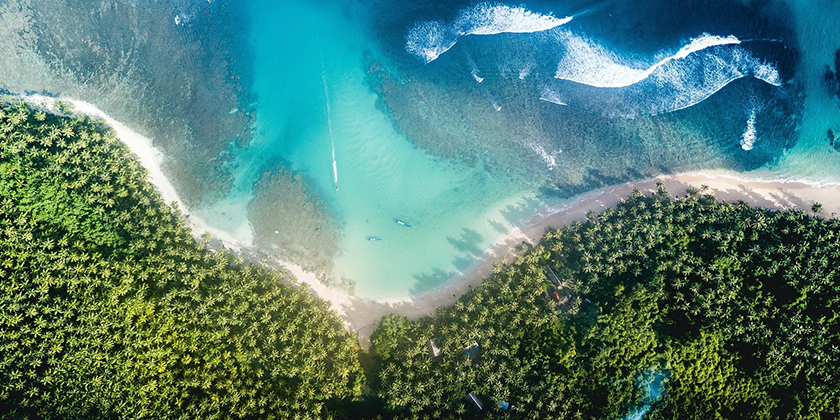Investment and collective action: The key to unlocking the blue economy
-

-
Khunapong Khunaraksa
-
May 14, 2022
-
6 min read

Khunapong Khunaraksa
May 14, 2022
6 min read


An estimated 11 million tonnes of plastic waste continues to flow into our oceans each year, the equivalent of one garbage truck of plastic entering the ocean every minute. The scale of the ocean plastic crisis is hard to believe, which is why we use visuals like this to help tell the story. While these numbers are immense, they can also tell a different story; one about how targeted solutions can present huge opportunities for change. For example, we know that we could eliminate almost 150 million tonnes of Greenhouse Gas (GHG) from the environment if we prevented 100% of the plastic leakage in India and Indonesia alone by 2030. This is the same amount of GHG savings derived from shutting down 40 coal-fired power plant.
We have this data available to us, so what do we do with this knowledge? Investors, in particular, have an opportunity to help address the plastic waste issue, fight climate change and capture the economic value of plastic.
These opportunities were amongst the many discussion topics at last month’s Impact Investment Summit, which brought together global thought leaders in the impact investment space to discuss the economic potential in preserving the value of the ‘big blue’. Asia specifically represents a large proportion of the ocean plastic problem, with nine of the top 10 rivers emitting plastic waste into the oceans in the Philippines. From an economic perspective, plastic pollution results in a loss of US$ 10.8 billion each year to the tourism, fishing, and shipping industries in the Asia-Pacific region.
These facts, while making clear the need for urgent action, can also be viewed as a useful guide for enacting solutions that could create the most impact. According to the Ocean Conservancy, a 45% reduction in plastic leakage is possible by investing in waste management and recycling in just five countries in Asia (China, Indonesia, the Philippines, Thailand, and Vietnam). Further, across the majority of these countries, the waste management and recycling industry lack efficient infrastructure, making them ripe for disruption.
The ticking clock on climate change means that we must skip models of incremental change and move to exponential impact. Asia can set the stage for the world’s next-generation model. As a consumption and production powerhouse, the region has the potential to showcase the circular economy at scale and in doing so, generate huge impact returns.
Agreement on the need for plastic action creates huge potential for change
The resolution from 175 nations earlier this year to create a landmark treaty to address the global plastic waste crisis signaled not only a recognition from governments, businesses, and the nonprofit sector that plastic pollution needs to be addressed but that there is a significant economic opportunity in doing so.
Coupled with this is the growing evidence that investing in plastic circularity could generate attractive economic returns. According to The Economic Research Institute for Asean and East Asia (ERIA), over the next 20 years, the adoption of circular economy principles in the region could lead to US$ 324 billion in economic growth and 1.5 million jobs created.
The challenge is to secure the billions of dollars needed to ensure adequate infrastructure and innovations are in place to transform the plastic economy. In fact, according to the Google Circularity Gap Study, more than US$ 430 billion needs to be invested over the next 20 years to ensure that circular supply chains can meet the global demand for plastics. From family offices to VCs, corporates, and institutional investors, ecosystem players with a range of risk appetites have an important role to play.
Turning waste into a resource will require at the outset catalytic and philanthropic capital – to invest in creating a strong sector in emerging markets, and prove that it can generate financial and impact returns. For example, our program, The Incubation Network, has engaged small and medium enterprises in waste management and recycling across South and Southeast Asia which have collectively received over US$ 500,000 in philanthropic grants. Corporate investors also have a role to play, not only through the injection of capital but by working with these local businesses to develop offtake agreements and connect them to global supply chains.
Institutional investors will only follow suit once the investment marketplace has been established, and they have access to track records and a pipeline of investable solutions. Simultaneously, we seek to bridge this financing gap by proactively offering research-backed insights and tools to reinforce the investment case of the circular plastics economy. For instance, in collaboration with the World Economic Forum’s Global Plastic Action Partnership (GPAP), The Circulate Initiative recently contributed to a toolkit that showcases how investors can seize the economic opportunities available today to help address the plastic waste crisis.
Working together to fill the gaps on the path to circularity
At The Circulate Initiative, we are heartened by the progress we are seeing, which is only made possible through continued collaboration and recognition by different sectors of the importance of ocean preservation.
We see a lot of our work as ‘filling the gaps’. We develop insights and tools to guide decision-making on investment and incubate solutions to fill gaps in financing, knowledge, data, and innovation that are hindering efforts in the ecosystem. We do not seek to do this alone — we are only effective through our network of partners and close collaborators; cities, investors, other nonprofits, and government organizations that help us to do our work.
With the global movement around action on sustainable development goals, the momentum is now building for the growth of the circular economy for plastics. Governments across Asia are setting the framework for action on plastic, investors are beginning to realize the potential of the circular economy, and big businesses are looking for ways to minimize or offset their environmental impacts.
While the opportunities for solutions are huge and individual actors are taking significant steps forward, a critical takeaway is an urgency for the entire ecosystem — corporates, governments, and nonprofits – to come together to fully realize their potential. The world is at a tipping point and we believe that only when we collaborate on solutions will individual efforts in circularity start to add up to more than the sum of their parts.
References:
The Pew Charitable Trusts and SYSTEMIQ (2020), Breaking the Plastic Wave: Top Findings for Preventing Plastic Pollution
https://www.pewtrusts.org/-/media/assets/2020/07/breakingtheplasticwave_report.pdf
Meijer LJJ, van Emmerik T, van der Ent R, Schmidt C, Lebreton L. (2021) More than 1000 rivers account for 80% of global riverine plastic emissions into the ocean.
https://pubmed.ncbi.nlm.nih.gov/33931460/
Circle Economy. (2022). The Circularity Gap Report 2022 (pp. 1-64, Rep.) Amsterdam: Circle Economy.
https://drive.google.com/file/d/1NMAUtZcoSLwmHt_r5TLWwB28QJDghi6Q/view
McKinsey & Company and Ocean Conservancy (2015), Stemming the Tide: Land-based strategies for a plastic-free ocean
https://oceanconservancy.org/wp-content/uploads/2017/04/full-report-stemming-the.pdf
EU-ASEAN Business Council (2020), Advancing ASEAN’s Circular Economy Agenda Advocacy Paper
https://aecvcci.vn/Modules/News/Uploaded/Document/2020081710311175_pdf.pdf